Many artists, whether well-known or unknown, create their own Christmas cards, not for any commercial purpose as such, but as a gift to family and friends. I like to do this and it is something that I really enjoy thinking about ahead of time. The cards may be a little unusual and sometimes contain enclosures or three-dimensional elements. Or they can be very simple indeed. They often focus on just one element of Christmas.
The media used varies from year to year, but a consideration is that several need to be made, one after the other, so something like a lino-cut, or a stencil, or a hand-made stamp can be useful - although I do sometimes hand-paint a design onto each. I make about 100 cards of these each year.
Here I will archive the cards, documenting twenty years of the designs.
More coming soon .....
Still in Covid times and some periods of lockdown in 2021, I have become really aware of the natural world on my daily walks, especially wild flowers/grasses/trees. I've started to press flowers/plants and use them in my artwork and have been getting to know many more botanical names of the new plants that I'm coming across. I've increasingly enjoyed nurturing and observing the plants in my garden and spending more time outdoors. So I started to look into all the plants/botanicals associated with Christmas to see if I could design a Christmas card featuring botanical elements. There were so many - it was impossible to include all of them. In the end I settled for Holly, Ivy, Orange, Ginger, Poinsettia, Fir and Mistletoe in order to achieve a variety of textures, shapes, colours, elements of plants - leaves, berries, fruits, roots, branches etc. I also wanted to incorporate popular Christmas traditions, stories, tastes and other associations. I decided to create a length of celebratory bunting for the recipient to assemble, plus a small, fragranced tea-light to light on Christmas Eve (with more botanical elements - Frankincense/Myrrh). I used a huge variety of techniques to make the seven pieces - hand-painting, cutting, stamping, collage, decorative cutting, stapling, gilding, digital printing, photography and illustration. I also added optional, interactive suggestions for the recipient to add their own eighth piece to the bunting. Packaging up all the pieces accurately took a great deal longer than I had planned!
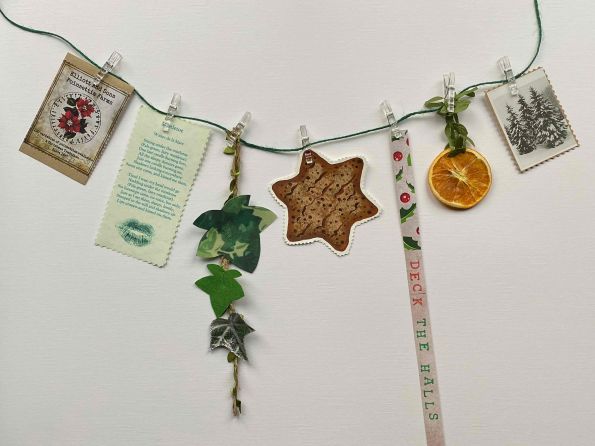








The idea of setting the Nativity story in Covid times, illustrated as a comic, as this year's Christmas card kept coming into my head. I dismissed it several times as it would require a lot of illustrations/hard work - and to complete it in time for the printing deadline seemed impossible. In the end, I just had to do it - this year's card needed to reflect the year we had had, dealing with Covid. I drew, and re-drew, the most bizarre Nativity story, as ideas came into my head - incorporating the way we communicated, worked, used social media, used PPE/face masks/testing, during Covid and lockdown in 2020. Cultural and political influences were included, via characters such as a Trump-style Herod and a Love Island-style Angel Gabriel. The story incorporates a tribute to our NHS workers (depicted as a host of angels) and the phenomenon of clapping/creating rainbows to thank them. Mobile phones and drones also make an appearance, as do Zoom and Microsoft Teams. I couldn't resist using a photo of my grandson Hugo as a reference to draw baby Jesus. The spiky, circular Covid virus particles appear throughout, sometimes minute, at other times the size of a planet and represent the constant threat felt at that time, but essentially this is a hopeful tale, in keeping with the original story of the Nativity. Colouring books were also very popular during this time to reduce stress/pass the time, so the comic was drawn entirely in black and white line, to be coloured by the recipient. A pack of twelve brightly coloured markers were supplied with each comic.
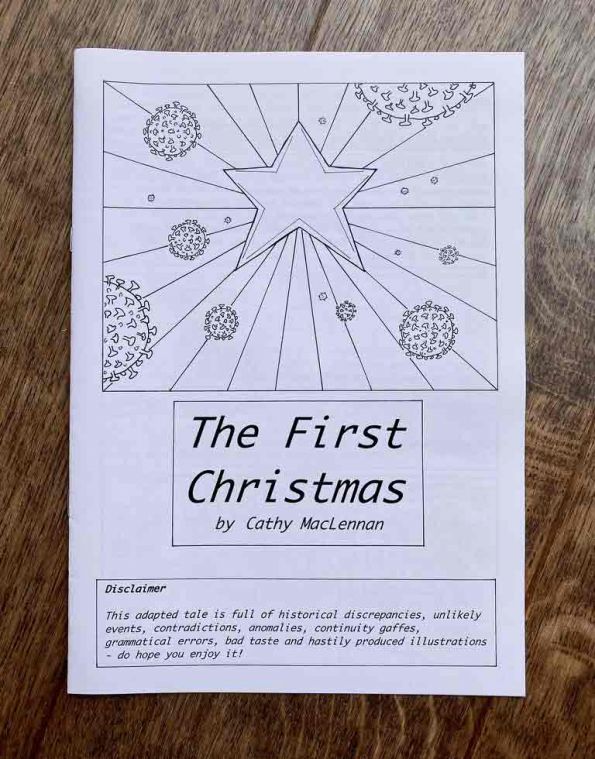




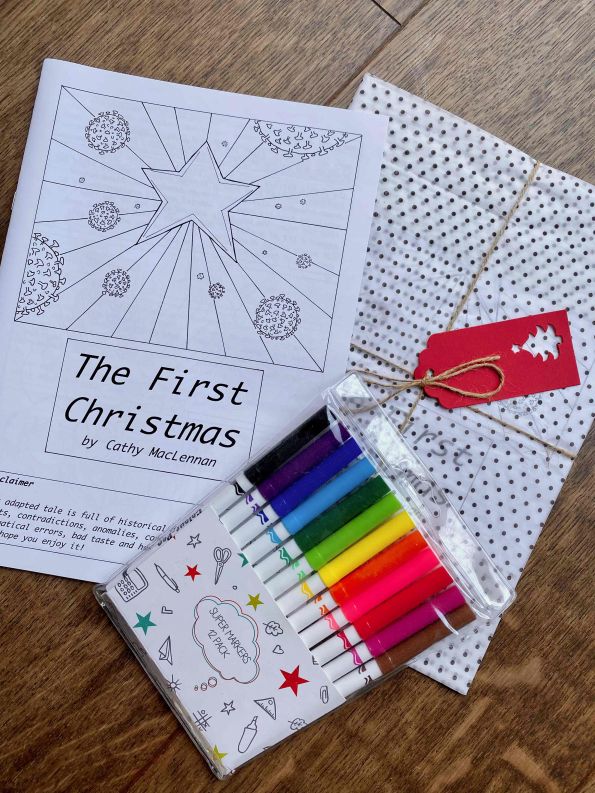
This year I thought I would focus on the donkey - a creature inextricably linked to Christmas, having carried Mary to Bethlehem in the Nativity story. Despite being beasts of burden throughout history, donkeys are such interesting and intelligent creatures. Noble, stubborn, clever, melancholic and somewhat comedic in appearance, donkeys are much loved and my aim was to produce something festive that celebrates 'All Things Donkey'. So I created a donkey tree decoration and an 'All Things Donkey' fact/info sheet. I made a hand-printed lino-cut image of a small donkey, using an original donkey illustration onto blue cotton. Hessian seemed a suitable, coarse fabric to use as a base - with frayed edges and zig-zag stitching. To make it more festive, I added a wooden star and a glittered, star and vintage twine hanger. Then I collected together donkey images, characters, facts, information and a poem and created a collaged, A3 kraft paper sheet to fold and wrap around the donkey tree decoration.



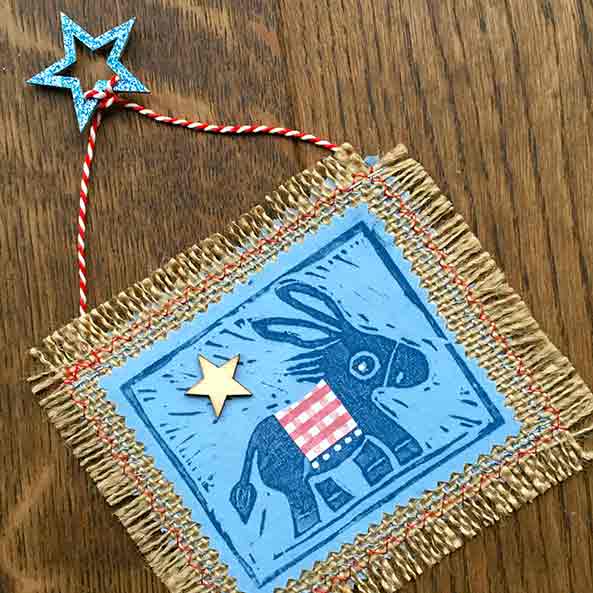
Entitled 'Telegram from Bethlehem', this year's Christmas card had a story-telling element via the words in a telegram sent by the visitor's to the stable in Bethlehem - and a visual element - the old photograph of Bethlehem with a large star and a simple Christmas tree. This year I've been working with cyanotypes, photos and other ephemera and I wanted to use these materials for the card. It can be displayed using the photo clip holder supplied with it. The cyanotypes were done over two sunny days in the summer - 8 at a time. The part that took the longest was hand sewing the tiny silver stars and folding/packaging the elements into a parcel tied with twine and silver thread. I was pleased with the magical, ethereal quality of the cyanotype image. I've included several images of the process as well as the final creation.








This idea for this Christmas card harks back to a childhood game that I played with my friends at school. We folded a square of paper, several times over, to create what we called a 'fortune teller'.To play involved choosing an image and then opening and shutting the device, spelling out the word, followed by a number choice and more opening and shutting of the device, counting, until at the end, the 'fortune teller' was opened to reveal a secret message. I decided to make a larger sized game so that it could also be displayed as a 3D object - it was very hard to decide on the correct weight of paper. I also decided that the festive, secret messages and images should all be positive and bright and that it was to look modern with clean lines. I found out during my research that not everyone used the 'fortune teller' name, but that they were also known as a 'chatterbox'. That name sounded better with the word Christmas, hence it became a 'Christmas Chatterbox'. Although it had several sections to print, it was actually very suitable to produce in numbers. The very hardest part was to fold them accurately - they simply didn't work if you didn't take care.


.jpg)
.jpg)

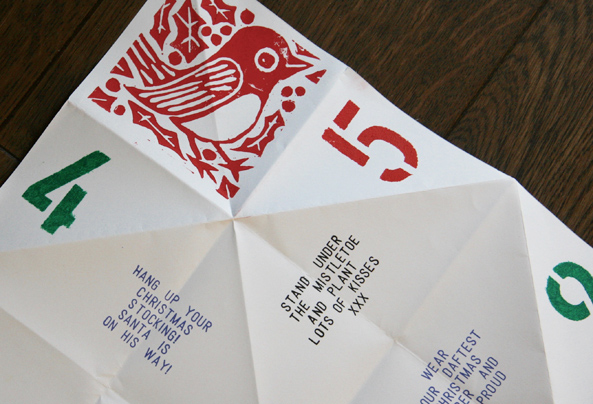
I've been dying to do this card for ages and had the idea for a 'festive paint chart' many years ago, inspired by some of the paint charts I used to choose paint colours for decorating my own home. They listed some lovely colours with rather daft, but descriptive names eg. a pale grey named 'Elephant's Breath'. It was great fun working out the names of all the colours, but then a little more technically challenging to reproduce on a card many times over. Additionally, I hand-painted a little illustration of a tightly-wrapped-up baby Jesus, on to a die-cut, wooden bauble using six of the paint chart colours. To make the link between the enclosure and the card, I underlined the six colour names in white ink. It took a very long time as I knew it would, but I just had to do it!





This is my second Christmas card with a story. I wrote 'The Tiny Robin' specifically for this card. The story is depicted in pages across the front and the back of the card which was folded into a consertina. It is a short, simple story of a robin flying for miles to the stable in the Nativity - and finding himself short of a gift for the baby king, he gives him one of his fine red feathers. Once folded, the card is my smallest so far. It was created from a wide array of materials listed above. I loved making it although it took longer than it was meant to!



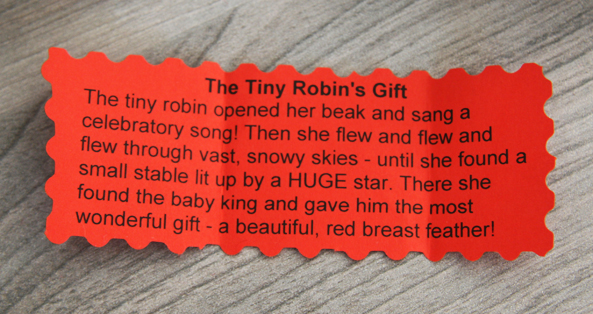


For the first time I decided to design a Christmas card that ties in with a book title. I selected a spread from my new Christmas book entitled When When When will it be Christmas? The spread features a mouse in a pink tutu, snipping paper, to make snowflake decorations for Christmas. I thought it would be fun to devise a kit from which the recipient could make their own snipped, paper snowflake. After much engineering and several prototypes, I made one that worked well. The most difficult job was creating a set of instructions and carefully drawing them out to be printed.
It was all a lot of fun, but took much longer than I expected.
It became an interactive card as many people sent photos or tweeted/texted images of their completed snowflakes!




This is the second Christmas card that I have based on gold, frankincense and myrrh. This time I have simplified the three into elements, colours and shapes. The canvas is abstract; the card illustrated with three icons. Both use a palette of primary colours plus black and white and gold. Both contain the same recognisable shapes.
I was inspired this year by my visit to Matisse's chapel at Vence in Provence and wanted to try using bright, primary, stained glass window colours and simplified shapes to illustrate a theme. It's a great deal harder than it looks.



'Star of Wonder' describes this card fully. A simple, collaged illustration of a 'huge, bold and wondrous star' above a small stable. Unintentionally, I have used the same theme as the previous year!
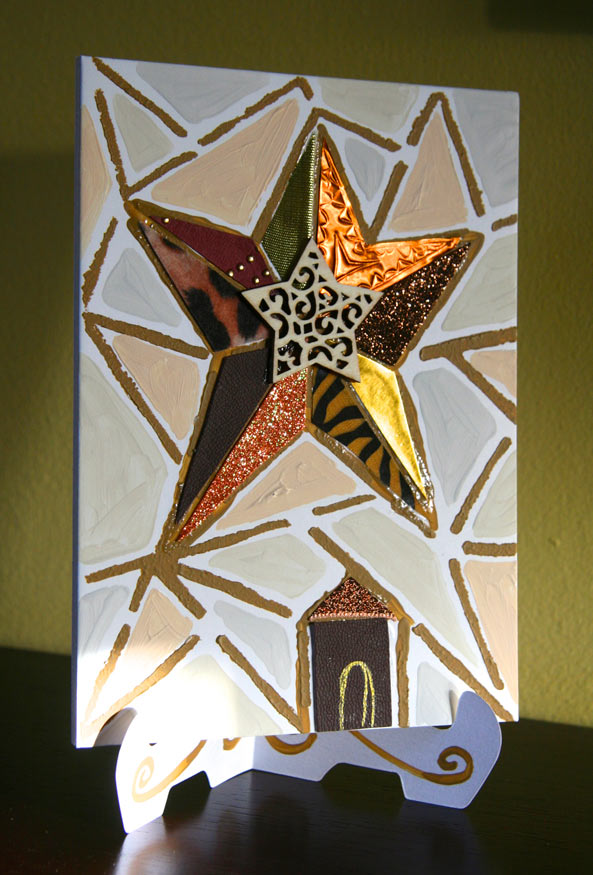

The idea for this card started with a snowy black and white photo of my studio, taken in 2010. I thought about the small cold barn in Bethlehem and the star that appeared above it, to mark it's significance. So it became 'A Star Appeared Over A Small Building'. This card is actually about the creation of something and creativity itself. And the card was also created inside this building. I enjoyed making the same image with different media, but printing a four part lino-cut on an uneven blank jigsaw is difficult!
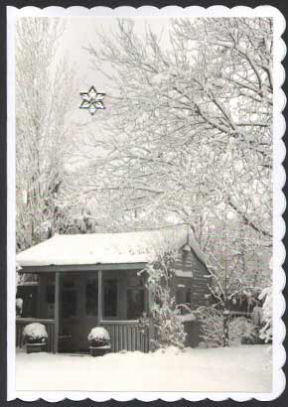
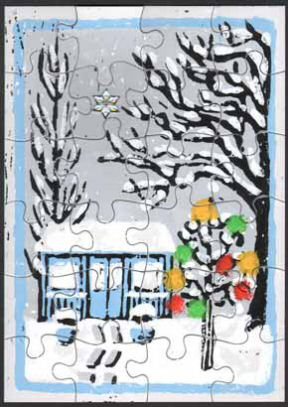


I had been using a new watercolour paintbox, which was a gift. I was thinking about what to paint with my brand new paintbox? From this came the idea of a 'Paintbox For Christmas' theme. I thought it would be fun to ask the recipients of my card, this question - "If you recieved a paintbox for Christmas - what would YOU paint?" So I painted for them, a paintbox and a Christmas tree tag and wrapped it like a gift. Many people replied with their ideas, so it ended up being an interactive card.



The theme chosen this year was 'peace'. I wanted to do something delicate, quiet, gentle and subtle. I decided on a 3D hanging decoration with a colour palette of blue, silver and white. Doves feature as symbols of peace and the white feather a symbol of surrender. Each piece is labelled with the words 'Little Piece of Peace' and numbered 1 - 5. I wanted to put in instructions and hoped that they would also be pegged onto the hanging.

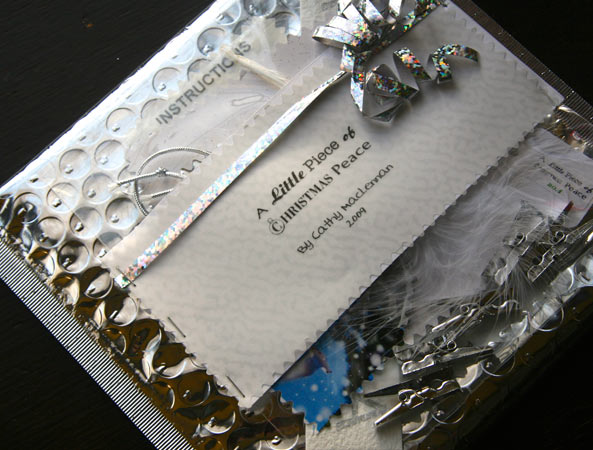


One of my simplest Christmas cards!
Despite putting away our Christmas tree lights carefully each year, they always had to be untangled and the bulbs screwed in and replaced, before they would work. An onerous task, not necessary now with LED lights. I still prefer the old fashioned fairy lights though! The design features a tangle of lights, plugged in at the wall. It is painted in the dry-brush style that I use in my children's books.

A playful Christmas card design including a Christmas paper chain kit in festive colours. When you look a little closer, it is actually a comment on consumerism at Christmas. The card design features a slightly stylized, baby Jesus reaching up towards a colourful paper chain. The paper chain pieces are covered in a wealth of images and the current, topical news relating to Christmas, both good and bad. Plenty for the recipient to read and think about, while they have fun making the paper chain!




The title 'Loud Star' is meant to suggest a huge and important star, as opposed to a noise/sound of some sort. It depicts the night sky with a large white star on a royal blue circle of card. It is received, folded twice. When you open it up and hang it by the ribbon, it also resembles a Christmas bauble.

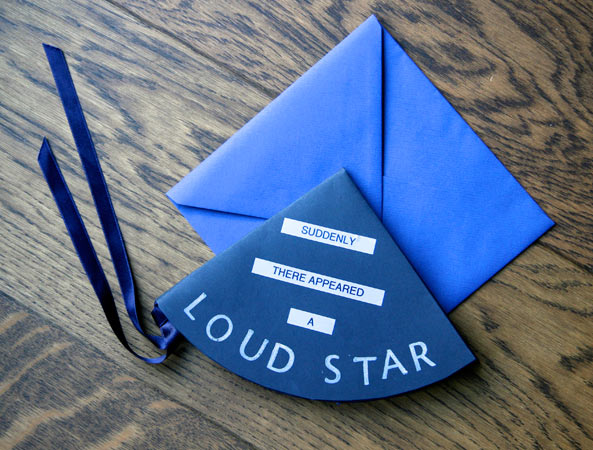
This is a small, very concise, be-ribboned, mini-book version of the Christmas story and includes the well known 'Baaaah Humbug' pun. I'm not a fan of the shortening of the word Christmas to Xmas, but as this is an exercise in being concise, it seemed right.






The thought behind this card design is that many notable people were Christmas babies ie. born on December 25th and there are official records that can confirm that they were born on this date. The irony is that, at Christmas, although we are celebrating the birth of a very famous baby named Jesus, no one actually knows his true birth date - many speculate that it is likely to have been at harvest time, but no-one knows. So all the Christmas Babies depicted on the cards, except Jesus, have their date of birth underneath.
I decided to use the very popular idea of baby footprints, stencilled on to each card. Then I threaded them on ribbon to make a hanging decoration.



I wanted to depict a message sent from Bethlehem as an air letter or postcard, as if the recipient was recieving the news of the baby being born in Bethlehem, at that time. I enjoyed making the stamp and was lucky enough to find the wooden baby blank shapes available commercially. In many ways it is very a simple card.



